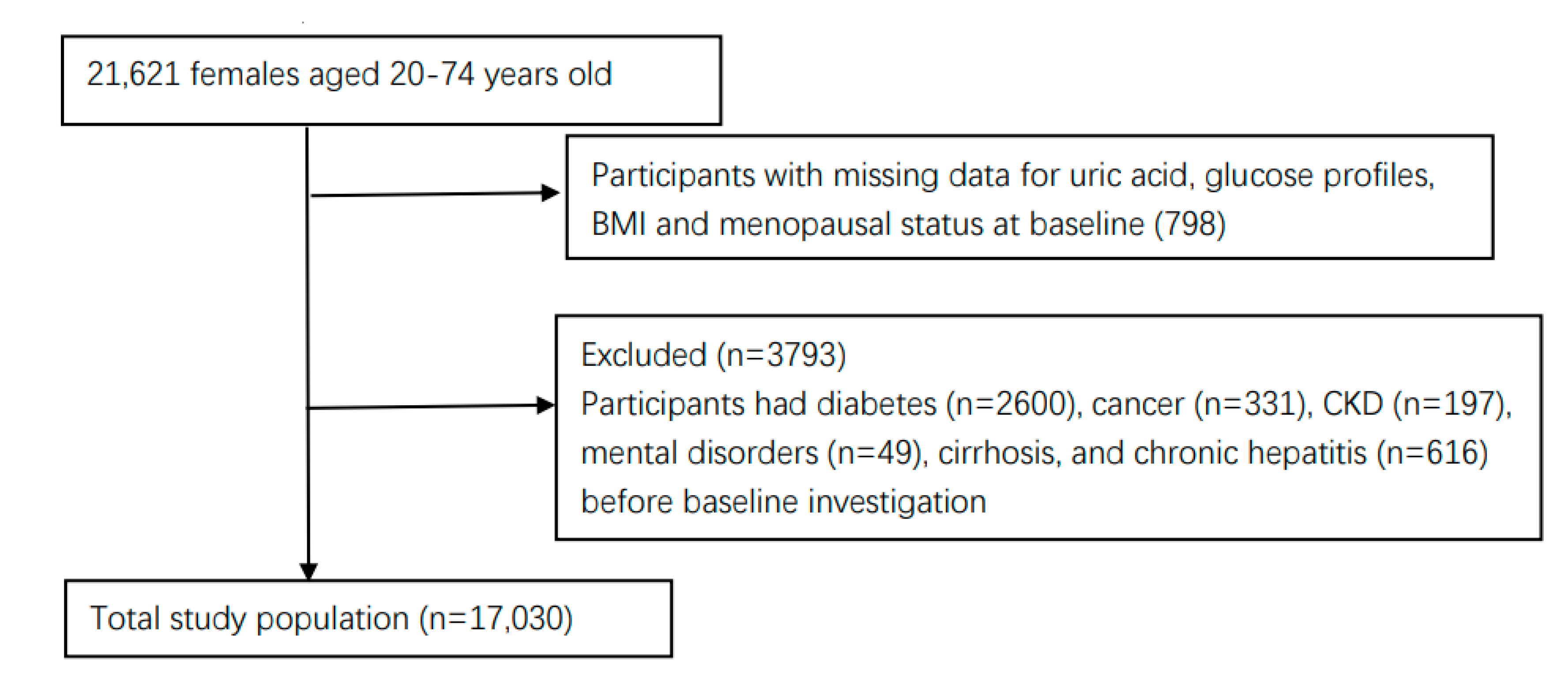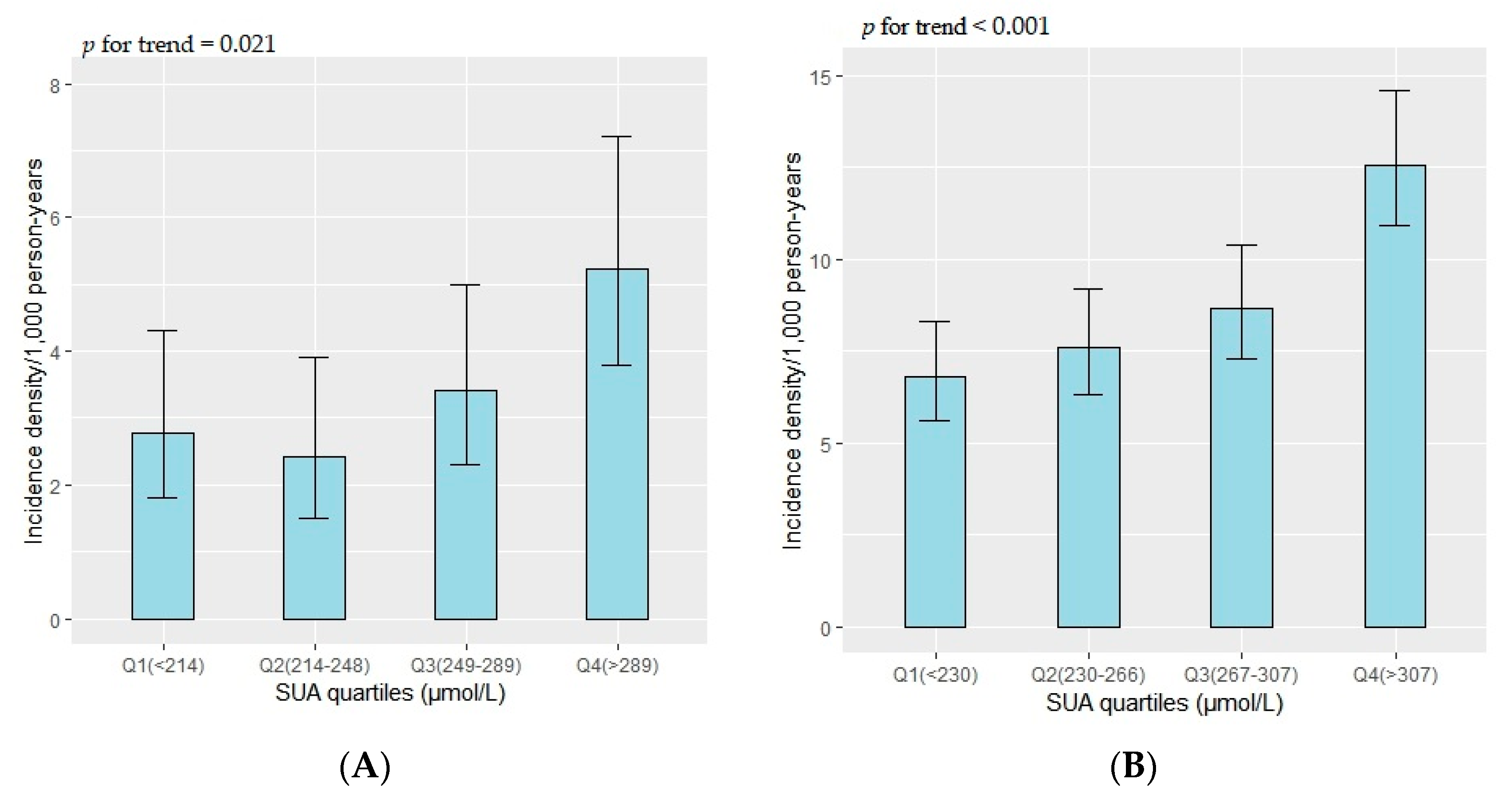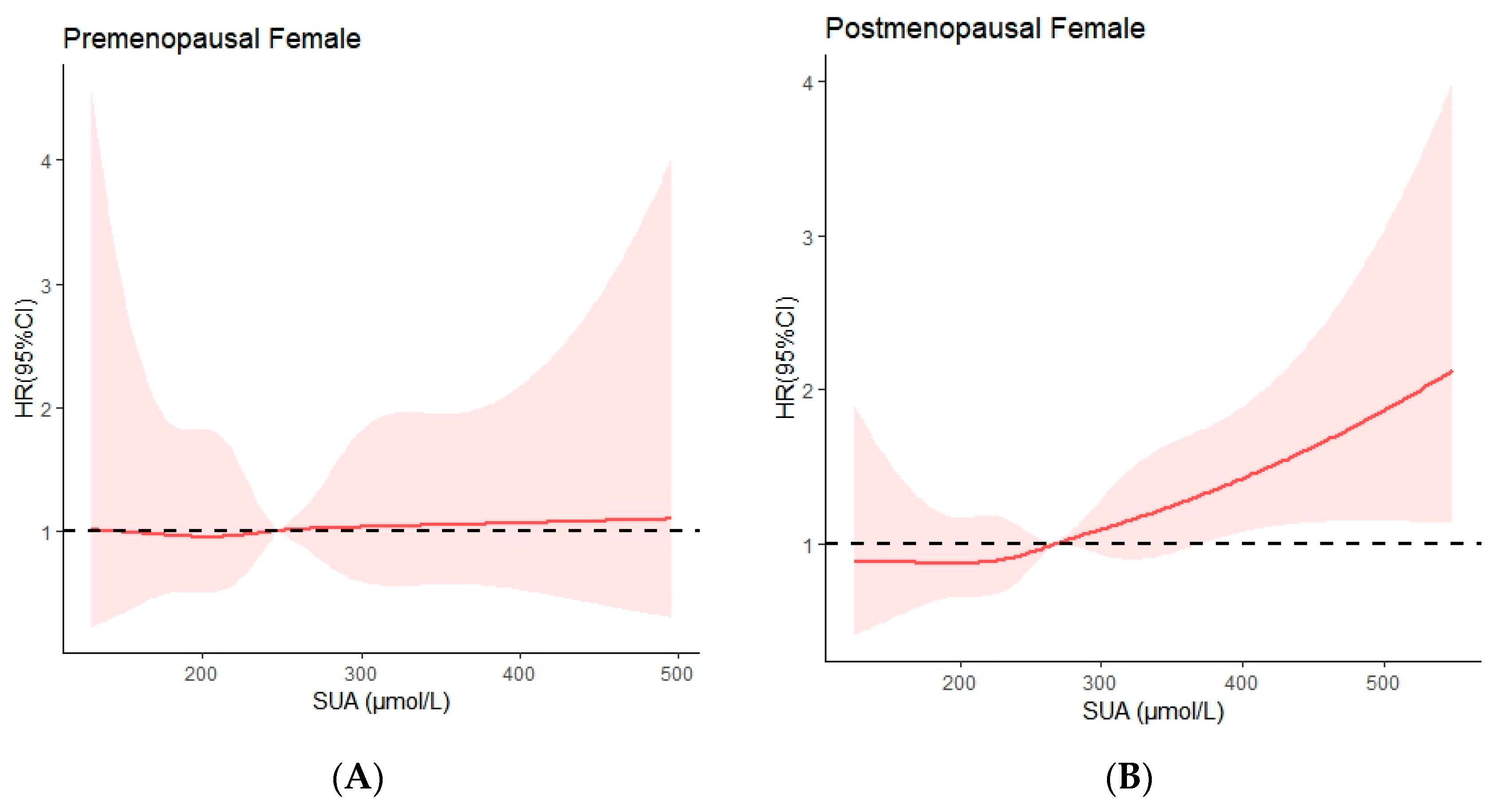Association of Serum Uric Acid with Diabetes in Premenopausal and Postmenopausal Women—A Prospective Cohort Study in Shanghai, China
Abstract
1. Introduction
2. Materials and Methods
2.1. Subjects
2.2. Data Collection
2.3. Blood Collection Laboratory Measurements
2.4. Menopausal Status
2.5. Diabetes Assessment and Follow-up
2.6. Diagnostic Criteria
2.7. Quality Control
2.8. Statistical Analysis
3. Results
3.1. Demographic Characteristics of the Study Participants
3.2. Incidence Density of Diabetes in Premenopausal and Postmenopausal Women
3.3. Association between SUA Levels and Diabetes in Premenopausal and Postmenopausal Women
4. Discussion
5. Conclusions
Author Contributions
Funding
Institutional Review Board Statement
Informed Consent Statement
Data Availability Statement
Acknowledgments
Conflicts of Interest
References
- International Diabetes Federation (IDF). IDF Diabetes Atlas 10th edition [EB/OL]. [6 December 2021]. 2021. Available online: http://www.diabetesatlas.org (accessed on 1 October 2022).
- Wang, L.; Peng, W.; Zhao, Z.; Zhang, M.; Shi, Z.; Song, Z.; Zhang, X.; Li, C.; Huang, Z.; Sun, X.; et al. Prevalence and Treatment of Diabetes in China, 2013–2018. JAMA 2021, 326, 2498–2506. [Google Scholar] [CrossRef]
- Krishnan, E.; Pandya, B.J.; Chung, L.; Hariri, A.; Dabbous, O. Hyperuricemia in young adults and risk of insulin resistance, prediabetes, and diabetes: A 15-year follow-up study. Am. J. Epidemiol. 2012, 176, 108–116. [Google Scholar] [CrossRef]
- van der Schaft, N.; Brahimaj, A.; Wen, K.X.; Franco, O.H.; Dehghan, A. The association between serum uric acid and the incidence of prediabetes and type 2 diabetes mellitus: The Rotterdam Study. PLoS ONE 2017, 12, e0179482. [Google Scholar] [CrossRef]
- Choi, B.G.; Kim, D.J.; Baek, M.J.; Ryu, Y.G.; Kim, S.W.; Lee, M.W.; Park, J.Y.; Noh, Y.K.; Choi, S.Y.; Byun, J.K.; et al. Hyperuricaemia and development of type 2 diabetes mellitus in Asian population. Clin. Exp. Pharmacol. Physiol. 2018, 45, 499–506. [Google Scholar] [CrossRef]
- Lou, Y.; Qin, P.; Wang, C.; Ma, J.; Peng, X.; Xu, S.; Chen, H.; Zhao, D.; Wang, L.; Liu, D.; et al. Sex-Specific Association of Serum Uric Acid Level and Change in Hyperuricemia Status with Risk of Type 2 Diabetes Mellitus: A Large Cohort Study in China. J. Diabetes Res. 2020, 2020, 9637365. [Google Scholar] [CrossRef]
- Lin, K.C.; Tsai, S.T.; Lin, H.Y.; Chou, P. Different progressions of hyperglycemia and diabetes among hyperuricemic men and women in the kinmen study. J. Rheumatol. 2004, 31, 1159–1165. [Google Scholar]
- Meisinger, C.; Thorand, B.; Schneider, A.; Stieber, J.; Döring, A.; Löwel, H. Sex differences in risk factors for incident type 2 diabetes mellitus: The MONICA Augsburg cohort study. Arch. Intern. Med. 2002, 162, 82–89. [Google Scholar] [CrossRef]
- Nan, H.; Qiao, Q.; Söderberg, S.; Pitkäniemi, J.; Zimmet, P.; Shaw, J.; Alberti, G.; Uusitalo, U.; Pauvaday, V.; Chitson, P.; et al. Serum uric acid and incident diabetes in Mauritian Indian and Creole populations. Diabetes Res. Clin. Pract. 2008, 80, 321–327. [Google Scholar] [CrossRef]
- Viazzi, F.; Leoncini, G.; Vercelli, M.; Deferrari, G.; Pontremoli, R. Serum uric acid levels predict new-onset type 2 diabetes in hospitalized patients with primary hypertension: The MAGIC study. Diabetes Care 2011, 34, 126–128. [Google Scholar] [CrossRef]
- Kivity, S.; Kopel, E.; Steinlauf, S.; Segev, S.; Sidi, Y.; Olchovsky, D. The association between serum uric acid and diabetes mellitus is stronger in women. J. Women’s Health 2013, 22, 782–789. [Google Scholar] [CrossRef]
- Wakabayashi, I.; Daimon, T. Associations of Blood Urate Level with Glycemic Status and Other Cardiometabolic Risk Factors in Middle-Aged Women. Women’s Health Rep. 2021, 2, 413–421. [Google Scholar] [CrossRef]
- Yamada, T.; Fukatsu, M.; Suzuki, S.; Wada, T.; Joh, T. Elevated serum uric acid predicts impaired fasting glucose and type 2 diabetes only among Japanese women undergoing health checkups. Diabetes Metab. 2011, 37, 252–258. [Google Scholar] [CrossRef]
- Yuan, Q.; Karmacharya, U.; Liu, F.; Chen, B.D.; Ma, X.; Ma, Y.T. Uric acid and its correlation with hypertension in postmenopausal women: A multi-ethnic study (Observational study). Clin. Exp. Hypertens. 2020, 42, 559–564. [Google Scholar] [CrossRef]
- Jung, J.; Kim, J.; Lee, Y.; Song, G.; Choi, S. SAT0693 Serum uric acid levels and hormone replacement therapy type: A retrospective case-control study of postmenopausal women. Ann. Rheum. Dis. 2017, 76, 1037–1038. [Google Scholar]
- Liu, J.; Zhao, Z.; Mu, Y.; Zou, X.; Zou, D.; Zhang, J.; Chen, S.; Tao, L.; Guo, X. Gender Differences in the Association between Serum Uric Acid and Prediabetes: A Six-Year Longitudinal Cohort Study. Int. J. Environ. Res. Public Health 2018, 15, 1560. [Google Scholar] [CrossRef]
- Han, Y.; Han, X.; Yin, Y.; Cao, Y.; Di, H.; Wu, J.; Zhang, Y.; Zeng, X. Dose-Response Relationship of Uric Acid with Fasting Glucose, Insulin, and Insulin Resistance in a United States Cohort of 5,148 Non-diabetic People. Front. Med. 2022, 9, 905085. [Google Scholar] [CrossRef]
- Zhao, Q.; Chen, B.; Wang, R.; Zhu, M.; Shao, Y.; Wang, N.; Liu, X.; Zhang, T.; Jiang, F.; Wang, W.; et al. Cohort profile: Protocol and baseline survey for the Shanghai Suburban Adult Cohort and Biobank (SSACB) study. BMJ Open 2020, 10, e035430. [Google Scholar] [CrossRef]
- Qiu, Y.; Zhao, Q.; Wang, N.; Yu, Y.; Wang, R.; Zhang, Y.; Cui, S.; Zhu, M.; Liu, X.; Jiang, Y.; et al. Association of hypertriglyceridemic waist phenotype with renal function impairment: A cross-sectional study in a population of Chinese adults. Nutr. Metab. 2020, 17, 63. [Google Scholar] [CrossRef]
- Tang, M.; Zhao, Q.; Yi, K.; Wu, Y.; Xiang, Y.; Cui, S.; Su, X.; Yu, Y.; Zhao, G.; Jiang, Y. Association between four nontraditional lipids and ischemic stroke: A cohort study in Shanghai, China. Lipids Health Dis. 2022, 21, 72. [Google Scholar] [CrossRef]
- Smokovski, I.; Milenkovic, T.; Cho, N.H. First stratified diabetes prevalence data for Republic of Macedonia derived from the National eHealth System. Diabetes Res. Clin. Pract. 2018, 143, 179–183. [Google Scholar] [CrossRef]
- Writing Group of 2018 Chinese Guidelines for the Management of Hypertension. 2018 Chinese guidelines for the management of hypertension. Chin. J. Cardiovasc. Medicine. 2019, 24, 24–56. [Google Scholar]
- Borghi, C.; Domienik-Karłowicz, J.; Tykarski, A.; Widecka, K.; Filipiak, K.J.; Jaguszewski, M.J.; Narkiewicz, K.; Mancia, G. Expert consensus for the diagnosis and treatment of patient with hyperuricemia and high cardiovascular risk: 2021 update. Cardiol J. 2021, 28, 1–14. [Google Scholar]
- National eGFR Project Collaboration Group. Improvement and evaluation of MDRD equation in patients with chronic kidney disease in China. Chin. J. Nephrol. 2006, 589–595. [Google Scholar]
- Zhu, R.J.; Gao, R.L.; Zhao, S.P.; Lu, G.P.; Zhao, D.; Li, J.J. Chinese Guidelines for the Prevention and Treatment of Dyslipidemia in Adults (2016 Revision). Chin. J. Health Manag. 2017, 11, 7–28. [Google Scholar] [CrossRef]
- Li, J.; Arafa, A.; Sheerah, H.A.; Teramoto, M.; Nakao, Y.M.; Honda-Kohmo, K.; Kashima, R.; Sakai, Y.; Watanabe, E.; Dohi, T.; et al. Serum uric acid levels and the risk of diabetes mellitus in premenopausal and postmenopausal women: The Suita study. Menopause 2022, 29, 1184–1188. [Google Scholar]
- Zhou, C.; Liu, M.; Zhang, Z.; Zhang, Y.; Nie, J.; Liang, M.; Liu, C.; Hu, W.; Song, Y.; Liu, L.; et al. Positive association of serum uric acid with new-onset diabetes in Chinese women with hypertension in a retrospective analysis of the China Stroke Primary Prevention Trial. Diabetes Obes. Metab. 2020, 22, 1598–1606. [Google Scholar] [CrossRef]
- Hak, A.E.; Choi, H.K. Menopause, postmenopausal hormone use and serum uric acid levels in US women--the Third National Health and Nutrition Examination Survey. Arthritis Res. Ther. 2008, 10, R116. [Google Scholar] [CrossRef]
- Kuwabara, M.; Hisatome, I.; Niwa, K.; Hara, S.; Roncal-Jimenez, C.A.; Bjornstad, P.; Nakagawa, T.; Andres-Hernando, A.; Sato, Y.; Jensen, T.; et al. Uric Acid Is a Strong Risk Marker for Developing Hypertension from Prehypertension: A 5-Year Japanese Cohort Study. Hypertension 2018, 71, 78–86. [Google Scholar] [CrossRef]
- Borghi, C.; Cicero, A.F.G. Serum Uric Acid and Cardiometabolic Disease: Another Brick in the Wall? Hypertension 2017, 69, 1011–1013. [Google Scholar] [CrossRef]
- Lee, S.H.; Kim, K.M.; Kim, K.N. Combined effect of serum gamma-glutamyltransferase and uric acid on incidence of diabetes mellitus: A longitudinal study. Medicine 2017, 96, e6901. [Google Scholar] [CrossRef]
- King, C.; Lanaspa, M.A.; Jensen, T.; Tolan, D.R.; Sánchez-Lozada, L.G.; Johnson, R.J. Uric Acid as a Cause of the Metabolic Syndrome. Contrib. Nephrol. 2018, 192, 88–102. [Google Scholar] [CrossRef]
- Su, H.; Liu, T.; Li, Y.; Fan, Y.; Wang, B.; Liu, M.; Hu, G.; Meng, Z.; Zhang, Q. Serum uric acid and its change with the risk of type 2 diabetes: A prospective study in China. Prim. Care Diabetes 2021, 15, 1002–1006. [Google Scholar] [CrossRef]
- Wardhana, W.; Rudijanto, A. Effect of Uric Acid on Blood Glucose Levels. Acta Med. Indones. 2018, 50, 253–256. [Google Scholar]
- Park, J.H.; Jin, Y.M.; Hwang, S.; Cho, D.H.; Kang, D.H.; Jo, I. Uric acid attenuates nitric oxide production by decreasing the interaction between endothelial nitric oxide synthase and calmodulin in human umbilical vein endothelial cells: A mechanism for uric acid-induced cardiovascular disease development. Nitric Oxide: Biol. Chem. 2013, 32, 36–42. [Google Scholar] [CrossRef]
- Johnson, R.J.; Kang, D.H.; Feig, D.; Kivlighn, S.; Kanellis, J.; Watanabe, S.; Tuttle, K.R.; Rodriguez-Iturbe, B.; Herrera-Acosta, J.; Mazzali, M. Is there a pathogenetic role for uric acid in hypertension and cardiovascular and renal disease? Hypertension 2003, 41, 1183–1190. [Google Scholar] [CrossRef]
- House, L.M., 2nd; Morris, R.T.; Barnes, T.M.; Lantier, L.; Cyphert, T.J.; McGuinness, O.P.; Otero, Y.F. Tissue inflammation and nitric oxide-mediated alterations in cardiovascular function are major determinants of endotoxin-induced insulin resistance. Cardiovasc. Diabetol. 2015, 14, 56. [Google Scholar] [CrossRef]
- Bi, Y.; Zhu, D.; Jing, Y.; Hu, Y.; Feng, W.; Shen, S.; Tong, G.; Shen, X.; Yu, T.; Song, D.; et al. Decreased beta cell function and insulin sensitivity contributed to increasing fasting glucose in Chinese. Acta Diabetol. 2012, 49 (Suppl. 1), S51–S58. [Google Scholar] [CrossRef]
- Galvan, A.Q.; Natali, A.; Baldi, S.; Frascerra, S.; Sanna, G.; Ciociaro, D.; Ferrannini, E. Effect of insulin on uric acid excretion in humans. Am. J. Physiol. 1995, 268 Pt 1, E1–E5. [Google Scholar] [CrossRef]
- Fox, I.H. Metabolic basis for disorders of purine nucleotide degradation. Metab. Clin. Exp. 1981, 30, 616–634. [Google Scholar] [CrossRef]
- Yagisawa, T.; Ito, F.; Osaka, Y.; Amano, H.; Kobayashi, C.; Toma, H. The influence of sex hormones on renal osteopontin expression and urinary constituents in experimental urolithiasis. J. Urol. 2001, 166, 1078–1082. [Google Scholar]
- Moreau, K.L.; Hildreth, K.L.; Meditz, A.L.; Deane, K.D.; Kohrt, W.M. Endothelial function is impaired across the stages of the menopause transition in healthy women. J. Clin. Endocrinol. Metab. 2012, 97, 4692–4700. [Google Scholar] [CrossRef]
- De Paoli, M.; Werstuck, G.H. Role of Estrogen in Type 1 and Type 2 Diabetes Mellitus: A Review of Clinical and Preclinical Data. Can. J. Diabetes 2020, 44, 448–452. [Google Scholar] [CrossRef]
- Wang, M.; Gan, W.; Kartsonaki, C.; Guo, Y.; Lv, J.; Chen, Z.; Li, L.; Yang, L.; Yu, M. Menopausal status, age at natural menopause and risk of diabetes in China: A 10-year prospective study of 300,000 women. Nutr. Metab. 2022, 19, 7. [Google Scholar]
- Alonso-Magdalena, P.; Ropero, A.B.; Carrera, M.P.; Carrera, M.P.; Cederroth, C.R.; Baquié, M.; Gauthier, B.R.; Nef, S.; Stefani, E.; Nadal, A. Pancreatic insulin content regulation by the estrogen receptor ER alpha. PLoS ONE 2008, 3, e2069. [Google Scholar] [CrossRef]



| Baseline Characteristics | Premenopausal Women | Postmenopausal Women | χ2/F/H | p |
|---|---|---|---|---|
| n | 5743 | 11,287 | ||
| Age (years, ± s) | 42.19 ± 9.15 | 60.31 ± 6.67 | −147.12 | <0.0001 |
| BMI (kg/m2, ± s) | 23.07 ± 3.32 | 24.19 ± 3.20 | −21.15 | <0.0001 |
| TG [mmol/L, (Q1, Q3)] | 1.08 (0.81,1.49) | 1.38 (1.03,1.87) | 631.32 | <0.0001 |
| LDL-C (mmol/L, ± s) | 2.55 ± 0.75 | 2.95 ± 0.84 | −29.78 | <0.0001 |
| HDL-C (mmol/L, ± s) | 1.51 ± 0.34 | 1.50 ± 0.34 | 1.07 | 0.283 |
| TC (mmol/L, ± s) | 4.64 ± 0.84 | 5.18 ± 0.92 | −37.26 | <0.0001 |
| eGFR (mmol/L, ± s) | 118.92 ± 23.65 | 105.26 ± 26.82 | 32.66 | <0.0001 |
| FPG (mmol/L, M (Q1, Q3)] | 4.57 (4.22,4.88) | 4.68 (4.23,5.25) | 105.19 | <0.0001 |
| HAb1C(mmol/L, ± s) | 5.37 ± 0.41 | 5.63 ± 0.40 | −38.73 | <0.0001 |
| Blood pressure (mmHg, ± s) | ||||
| Systolic | 122.91 ± 17.97 | 135.84 ± 19.06 | −42.25 | <0.0001 |
| Diastolic | 75.87 ± 10.82 | 79.67 ± 9.98 | −22.63 | <0.0001 |
| SUA range (µmol/L) | 290–576 | 308–653 | ||
| SUA (µmol/L) | 254.75 ± 57.94 | 272.63 ± 61.49 | −18.29 | <0.0001 |
| Education (year, %) | 4578.90 | <0.0001 | ||
| <7 | 930 (16.2) | 7102 (62.9) | ||
| 7–9 | 2596 (45.2) | 3266 (28.9) | ||
| 10–12 | 991 (17.3) | 864 (7.7) | ||
| >12 | 1226 (21.3) | 55 (0.5) | ||
| Marital status (%) | 35.46 | <0.0001 | ||
| Married | 5387 (93.8) | 10,293 (91.2) | ||
| Unmarried/Divorced/Widowed | 356 (6.2) | 994 (8.8) | ||
| Current smoking (%) | 40 (0.7) | 149 (1.3) | 13.49 | <0.0001 |
| Current alcohol drinking (%) | 63(1.1) | 162 (1.4) | 3.34 | 0.068 |
| Physical activity (%) | 1899 (33.1) | 3423 (30.3) | 13.30 | <0.0001 |
| Hyperuricemia (%) | 256 (4.5) | 903 (8.0) | 75.32 | <0.0001 |
| Hypertension (%) | 1323 (23.0) | 6170 (54.7) | 1545.28 | <0.0001 |
| Dyslipidemia (%) | 810 (14.1) | 3104 (27.5) | 385.92 | <0.0001 |
| Events/N (%) | Model1 | Model2 | Model3 | |
|---|---|---|---|---|
| Premenopausal women | ||||
| Q1 | 20/1414 (1.4) | 1.00 | 1.00 | 1.00 |
| Q2 | 18/1459 (1.2) | 0.94 (0.50–1.78) | 0.87 (0.46–1.64) | 0.85 (0.45–1.61) |
| Q3 | 25/1457 (1.7) | 1.26 (0.70–2.27) | 1.01 (0.56–1.84) | 0.96 (0.53–1.74) |
| Q4 | 37/1413 (2.6) | 1.89 (1.09–3.27) | 1.21 (0.68–2.16) | 0.99 (0.55–1.79) |
| Hyperuricemia | ||||
| No | 96/5680 (1.7) | 1.00 | 1.00 | 1.00 |
| Yes | 4/63 (6.3) | 4.17 (1.53–11.35) | 2.69 (0.97–7.43) | 1.89 (0.67–5.31) |
| SUA (every 10 µmol/L increase) | 1.52 (1.16–1.99) | 1.02 (0.99–1.06) | 1.01 (0.97–1.04) | |
| Postmenopausal women | ||||
| Q1 | 93/2801 (3.3) | 1.00 | 1.00 | 1.00 |
| Q2 | 105/2835 (3.7) | 1.12 (0.85–1.49) | 1.06 (0.80–1.41) | 1.06 (0.80–1.40) |
| Q3 | 116/2784 (4.2) | 1.27 (0.97–1.67) | 1.14 (0.87–1.51) | 1.10 (0.84–1.46) |
| Q4 | 171/2867 (6.0) | 1.81 (1.40–2.32) | 1.49 (1.15–1.94) | 1.39 (1.07–1.81) |
| Hyperuricemia | ||||
| No | 415/10384 (4.0) | 1.00 | 1.00 | 1.00 |
| Yes | 70/903 (7.8) | 1.92 (1.49–3.48) | 1.64 (1.26–2.13) | 1.55 (1.19–2.02) |
| SUA (every 10 µmol/L increase) | 1.04 (1.03–1.06) | 1.03 (1.02–1.04) | 1.03 (1.01–1.04) |
Publisher’s Note: MDPI stays neutral with regard to jurisdictional claims in published maps and institutional affiliations. |
© 2022 by the authors. Licensee MDPI, Basel, Switzerland. This article is an open access article distributed under the terms and conditions of the Creative Commons Attribution (CC BY) license (https://creativecommons.org/licenses/by/4.0/).
Share and Cite
Wu, Q.; Guan, Y.; Xu, C.; Wang, N.; Liu, X.; Jiang, F.; Zhao, Q.; Sun, Z.; Zhao, G.; Jiang, Y. Association of Serum Uric Acid with Diabetes in Premenopausal and Postmenopausal Women—A Prospective Cohort Study in Shanghai, China. Int. J. Environ. Res. Public Health 2022, 19, 16137. https://doi.org/10.3390/ijerph192316137
Wu Q, Guan Y, Xu C, Wang N, Liu X, Jiang F, Zhao Q, Sun Z, Zhao G, Jiang Y. Association of Serum Uric Acid with Diabetes in Premenopausal and Postmenopausal Women—A Prospective Cohort Study in Shanghai, China. International Journal of Environmental Research and Public Health. 2022; 19(23):16137. https://doi.org/10.3390/ijerph192316137
Chicago/Turabian StyleWu, Qian, Ying Guan, Chunze Xu, Na Wang, Xing Liu, Feng Jiang, Qi Zhao, Zhongxing Sun, Genming Zhao, and Yonggen Jiang. 2022. "Association of Serum Uric Acid with Diabetes in Premenopausal and Postmenopausal Women—A Prospective Cohort Study in Shanghai, China" International Journal of Environmental Research and Public Health 19, no. 23: 16137. https://doi.org/10.3390/ijerph192316137
APA StyleWu, Q., Guan, Y., Xu, C., Wang, N., Liu, X., Jiang, F., Zhao, Q., Sun, Z., Zhao, G., & Jiang, Y. (2022). Association of Serum Uric Acid with Diabetes in Premenopausal and Postmenopausal Women—A Prospective Cohort Study in Shanghai, China. International Journal of Environmental Research and Public Health, 19(23), 16137. https://doi.org/10.3390/ijerph192316137





